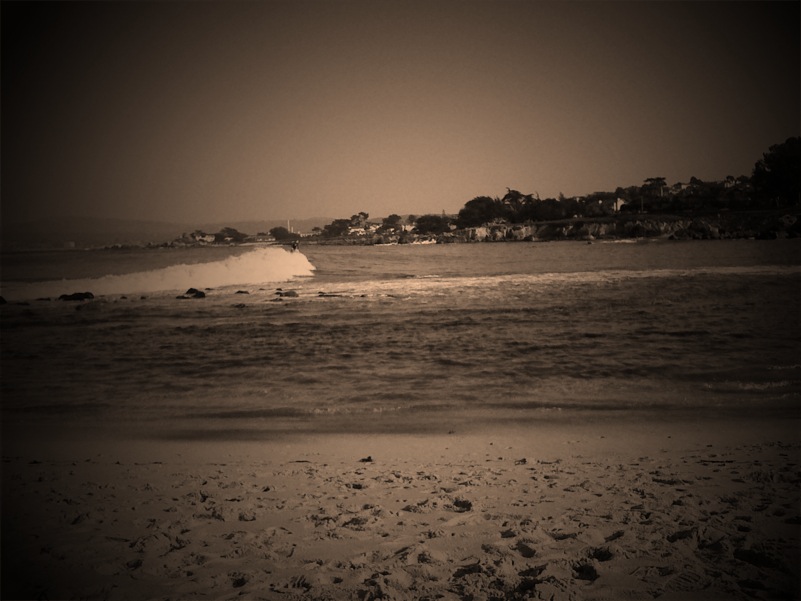
By: Grainne Rhuad
My driving companion glares at me and makes the remark, “You are the worst map reader in the world.”
“Careful,” I reply, “you’re coming dangerously close to giving me the highest of compliments and I don’t think that is your intention at all.”
In fact, I am not a poor map reader. I learned how to read maps in school in the days when it was mandatory information; back before we had George Jetson-like computers to tell us where they think we should go. I am a good map reader; I just don’t like them, especially when I am on holiday. I see them as a hindrance to me experiencing what the universe would have me experience on my adventure.
We are currently somewhere between Santa Cruz and Watsonville and not to my mind off course at all. After all, I can still see the ocean, which I tell my companion to follow. “Follow the Ocean and everything will be fine, we are headed to the beach after all. “ It is a refrain that two generations of my family will learn well this trip, and I hope it sticks. If where you are going is within sight, you are not lost.
Later on in the trip my driving companion asks me the question. “What do you think Steinbeck liked about living in this area?”
We are currently in Salinas, surrounded by farm country. Artichokes, strawberries and lettuce stretch out as far as the eye can see going east and to the west where the fog banks whisped in from the ocean. I think a while about my response. There is much here to like but I try to envision it as Steinbeck may have seen it. It’s a little easier in the countryside, farming has not changed much. As you get closer to the center of any given settlement however, there is much that has changed. The obligatory strip malls have moved in. Car lots abound, both for new and used vehicles. But there is much here that is the same.
I think about the fact that this has always been a literary place; it boasts the first library and college in California, both founded when Monterey was still a part of Mexico. Also it had the first newspaper in California, The Californian which was established in 1846 by a Kentucky Frontiersman, but I don’t think that’s really the answer.
“I think he liked that he was around people with stories. Solid working people who he knew and related to. People with something to impart when they shared it. People who lived full lives, working hard and playing with abandon.
“But I also think he liked the terrain itself. You have mountains and forests within walking distance. For contrast you can walk in the other direction and find sand dunes and rolling hills, and always the ocean at your back with its internal push and pull. As a writer, or an artist, it’s easy to see what the attraction is. One could easily be amongst people and yet one could easily go away, isolate, dream. “
Dreaming is so essential to the artist. And there are plenty of places to do it here in the Monterey Bay.
Cannery Row
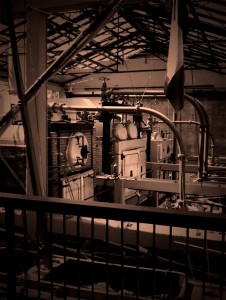
Monterey is a town that was built up around a single industry. Fishing. Mainly Sardines. In this town where Cannery Row is legend, the thing that was canned was sardines. The last cannery closed in the 1950’s due to overfishing of the small and cheap fish; but before that it was a bustling industry mostly due to the fact that sardines were cheap food for the poor, as well as a Portuguese staple, many of whom had made their homes in the area.
The Real Cannery Row was a tough place to eke out a living, a place where cannery barons made millions on the backs of laborers making 35 cents an hour. No minimum wage, no hours, no retirement, no safety net, no nothing. And yet due to the romanticism that millions of readers placed on it, it has become a place of legend.
“Cannery Row in Monterey in California is a poem, a stink, a grating noise, a quality of light, a tone, a habit, nostalgia, a dream. Cannery Row is the gathered and scattered, tin and iron and rust and splintered wood, chipped pavement and weedy lots and junk heaps, sardine canneries of corrugated iron, honky tonks restaurants and whore houses, and little crowded groceries, and laboratories and flophouses. Its inhabitants are, as the man once said, ‘whores, pimps, gamblers and sons of bitches,’ by which he meant Everybody. Had the man looked through another peephole he might have said, ‘Saints and angels and martyrs and holy men,’ and he would have meant the same thing.”- John Steinbeck; opening lines of Cannery Row
It was in the 70’s that I first remember visiting Monterey. The place was rundown. The canneries still stood with their paint peeling and the smell of sardines still in the air. The Aquarium had not yet opened and the area itself still held historic places almost in stasis. Doc Rickett’s lab was still there. The Wing Chong market, The Mackerel Jack’s Trading company which used to be a Bordello written about by Steinbeck. You may recognize it as “The Bear Flag” and La Ida’s Café, which only recently closed for good. Kalisa Moore finally succumbed, as we all do to age, taking with her the legacy of belly dancing on the bar for servicemen and workers alike.
Thankfully, this trip around I was surprised to find an exhibit included in the Monterey Bay Aquarium of what a working cannery would look like. There were guided tours and videos of workers as they did the hard monotonous job of canning sardines. When asked why it was a working class food then and so incredibly expensive now, the answer was not surprising. Overfishing killed off even sardines to the point where they are now specialty items. A strange world we live in where a food that nobody but the poor would eat in 1950 has turned into something you will find in specialty shops and for $16 a plate and up in restaurants.
Another new exhibit that warms the heart is one of Doc Rickett’s Lab. Among his actual collection,were sea creatures he used to take to schools for introducing the strange and somewhat new world of marine biology to school children. We all owe a lot to this man and his obsession, and not surprisingly, it was one of the only exhibits I had a hard time seeing due to the fact that 3-7 year olds were crowded around still ooohing and ahhing over the weird animals of the deep, suspended forever in jars.
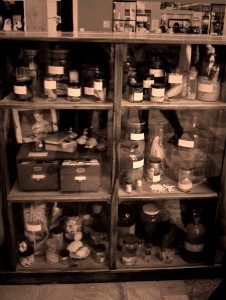
As for Cannery Row itself, it’s hardly worth the walk. Gone are the unusual, strange and weird, and it its place are chain stores and overpriced restaurants with gimmicks like Bubba Gumps , Louie Linguinis’ and the Steinbeck memorial mall which bears the overpowering smell of fried things on a stick and cotton candy.
People tend to forget that those who work in these places can no longer afford to live anywhere near Monterey. A prime example of this was our waiter. We asked him what was being served in the kitchen. My companion having been a waiter in Monterey, knows that the kitchen staff cooks up a hearty meal around lunch for staff every day. Where he worked it was largely Portuguese fair, think hearty, spicy fish stews. These things never make it to the menu. Our waiter replied he missed that and rarely gets a chance to eat at the restaurant as he has to travel inland to his second job right after his shift. Salinas is where most people have their second jobs and can afford to live. Things change and at the same time they stay the same. We were also more than a little entertained to watch the staff watching Rachel Ray’s cooking show on their down time in between orders….Just weird.
Another thing that’s easy to forget about Monterey with all its press about being a town that celebrities like Clint Eastwood like to make home and the beauty of the beaches, is it was at one time one of the biggest Military Bases in California.
The now Closed Fort Ord provided a background of a different sort for this area. During WWII our Californian coastline was of great concern, naturally. We were at war in the Pacific Islands. It was during this time that Fort Ord was opened. It provided a good deal of natural land for war games and housing for military families. There are miles of barracks, both for single soldiers and families. In fact, it is the size of an entire city. One of my traveling companions spent almost a year of his high school life living with his family on base and remembers that there wasn’t much that you needed to leave for. One of the siren songs that induced men (and boys) off base however was prostitutes. Situated not far off base with their home base an old run-down McDonalds, the prostitutes used to roam practically unmolested by law enforcement. This is not surprising; where soldiers are prostitutes will also be; this is a law so ancient that it is honored by practically everyone from wives to clergy. Men who are getting ready to possibly die for their country need some physical contact after all, and women need to make money for so many reasons, they are uncountable.
We were surprised when we drove through this part of town on this trip. It was on the way to our lodgings and not only the look of it; Strip malls, Targets, Chain Restaurants, etc; but also the feel of it had changed. The prostitutes had left. This left me wondering. Where did they go? We knew Fort Ord had closed down. It had been converted to a city college and unsurprisingly, the PX had been sold to a box store – think Sam’s club or Costco. Houses that had housed families were now dormitories and various used book stores. But for some reason I couldn’t get out of my mind, what had happened to the hookers? There’s no union for hookers, no retirement and no special Old Folks home. Did they fade away when no longer needed, becoming bag ladies? Or did they more likely follow the money to the interstate where one can still turn a trick for a trucker at any truck stop along I-5? It was a little bit sad to me to think of a whole sector of society that will not get a museum, plaque or even a second thought but had made up such a big part of the economy of this area.
Visiting Carmel
Six miles south of Monterey lay the township of Carmel-by-the Sea, a pretty little town of homes built on a steep hill overlooking a long sandy beach. It is notoriously Bourgeois and expensive to boot. However it also houses the first Spanish Mission in California; Mission Carmel; which is also one of the few Missions whose parish is still active. So off we went without a map to visit the final resting place of Father Junipero Serra.
This was an educational stop. All school children in California do a unit on missions and mission life. Usually, The Sainted Father Junipero Serra is outlined as a good and kindly aesthetic whose only concern was to bring souls to his God. This may very well be the case, however, the way in which he brought souls to his God was anything but kindly. Natives were set up in a peasant caste role and did all of the hard labor. In addition, missions would typically destroy natural habitat surrounding them, and plant herbs, vegetables and plants within mission walls making it sometimes necessary to comply in order to eat.
Beyond all of the ugliness however, Missions today are very beautiful places to visit. They have a haunting quality to them, probably because they ate so many spirits in their making, but you definitely feel not quite alone. The gardens are beautiful and there is much to be learned about the history of trade and architecture in early California. For example, this trip we tagged along behind a school group on a field trip and learned that the windows in the chapel of the dead were made of thinly sliced shell and sent to Father Serra as a gift by the then King of Siam. One has only to kneel down and touch the well worn adobe floor bricks to feel the smooth prints made by generations of subjugates kneeling in prayer. There are distinct dips where knees go. There is more wear at the altar of Mary the Mother of God than any other alters in the Church, which says a lot about who was praying.
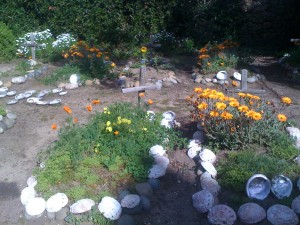
It was after leaving the mission was when those in my car began to get nervous about the lack of a map, which was again pointed out to me. “Look” I said. “The Ocean is right there, we are heading to the beach anyway, we will be fine, and we will discover something new.” Which we did. We discovered that Carmel-by-the-Sea may be worth the high property prices. Around every corner and up every hill was a magical cottage clinging to the hillside and gazing into the sea. Tall trees surrounded all and it became a game to find the cutest house. It became a game for the driver to stay out of the way of construction crews. The single lane roads were littered with them, new houses being tucked into amazingly small spaces that looked like someone’s garden. Another thing we learned is Carmel-by-the-Sea has the worst road markers ever. Painted on 2×4’s stuck at corners, I have seen more legible road markers in the back hills of the Sierra Nevada’s. It seemed that as magical as the town was, you really were not welcome to stay.
We did find our way to the ocean sans map, Oceans after all don’t move…much and all one has to do is point their vehicle in the direction of one and you will get there eventually. If one wishes to spend the afternoon daydreaming in warm sand, Carmel-by-the-Sea is one of the best beaches to do it. A little bit windy for some, if you lay down low you miss the wind and the rest is lost in afternoon daydreams.
An Afternoon in Big Sur
A half an hour further south you enter the area called Big Sur. Big Sur is famous for its mad artists, well photographed coastlines and yearly forest fires. There are two sides to Big Sur, the tourist presentation which includes the beautiful beaches and redwood hiking trails, the overpriced boutiques and lodges and the Art that artists chose to share. These are all so well documented by magazines, calendars and travel shows that almost everyone knows Nepenthe is “The Place to Eat!” the views being spectacular. I highly recommend not eating there as the food is not fabulous and overpriced and the view is free, there are benches and pillows set up everywhere so one can take in the spectacular sights of eagles nesting and the ocean mating with the craggy coastline. For those of you just sure that the staff is giving you the evil eye for not ordering, position yourself on the brunch house deck and give a tip to the servers, they will appreciate this more than making you a $12.00 plate of scrambled eggs and will leave you alone to draw, snap pictures or meditate.
The underside of Big Sur includes the more interesting things. For example high in the hills there is a man who has made a home out of a pickle jar. A huge old wood cask the size of a winery barrel, this comfortable home was free when it was made; it was also placed on squatted on land. Who knows how property like that would even change hands nowadays?
Of late everyone is aware of the artist who balances rocks and makes his home in Big Sur. You can see his gallery from the roadside, but my favorite artist is a photographer who can see faeries. I came across this artist by accident several years back when one night from the porch of my rented cabin; drum beats called me into the forest. What I found there was the most fun and taking pictures was Brock Bradford, of Heart Beat, a studio and shop at the Big Sur River Inn.
Big Sur River Inn itself is a jewel that a traveler may easily pass up. Nestled up against the highway it looks like nothing more than a gas station and a strip of 1940’s style motel rooms. Inside the inn you find the surprise of a restaurant that opens up to the most magical lawn leading down to a creek through the woods. It is the perfect respite from the world and once you cross the doorway you forget the highway. It is also an excellent restaurant with more reasonable fare. Its humble beginnings were with Pie and who doesn’t like a story that begins with Pie?
All good trips come to an end
The trip ended with another accidental discovery. Hungry travelers on a mission to eat vegetarian, we stumbled upon the best neighborhood for food not too far from Lover’s Beach. Lover’s beach itself is a lovely throw back with its restored bath house and single swan boat saved from death. It was an attraction in the 40’s and now is a small picnicking area ideal for families as the shallow beach has less of a break and swimming is good there for kids.
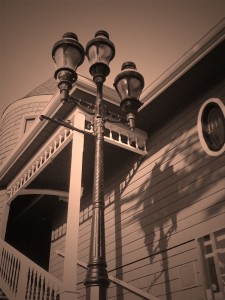
In any case not more than a few blocks away was a neighborhood that seemed to have a restaurant for every culture, from Thailand to Afghanistan. If you had a taste for it you could find it. I highly recommend this little strip of restaraunt, used book stores and thrift shops, located on Lighthouse and Central Aves.
We were on our way out of town when again a reminder of just what was so special about this area made itself known. Huge metal flowers in juicy colors looking like they belonged on the set of Tim Burton’s Alice in Wonderland called to me from what looked like a fenced in yard. Pulling over my driving partner told me I had to see this place. “This old guy has always been here as long as I can remember and you will not believe the stuff he has.”
Indeed I couldn’t, Jorge & Stella Rodriguez’ Crystal Rose was stuffed with fountains made from recycled tin festooned with neon lights, a huge array of Don Quixote statues in different attitudes made from driftwood and metal and limestone and what looked like whatsoever came to hand. Peeking in the work area I found unfinished projects which were mostly more interesting than the stuff in the main house which served as the show-room. Tucked in a corner was a limestone mantle that could hold an entire tree. Coming up behind me our host told me it was recovered from someone who owed him money in Mexico. “He wouldn’t pay me so I took the mantle.” Fascinating stories poured forth of trips to estates in Mexico, to salvage tin and stone to make the art before us. Who knows if all of it was true, I really didn’t care. The stories were worth the price of the 3 fantastic flowers we ended up buying.
You see it is this; the people who have stories, who live lives and the easy availability of escape from reality. The thin sidestep between hard labor and daydream that I think kept someone like John Steinbeck anchored here and which calls to others.
http://www.mchsmuseum.com/historypages.html
http://www.bigsurriverinn.com/history.html

a house made out of one pickle jar, that is amazing ….. I loved reading this, it is most likely better than actually visiting the same places for me, because it is filled with your POV and interests … thanks .. if you took a picture of that house made out of a pickle jar, send it my way … would hate to fly all that way to see just that …
I love that philosophy; if you can see the ocean, you can’t be lost. I used to hike all through the woods while growing up. I never really worried about getting lost, because the mountainside led down to the inlet. If i couldn’t find the trail i used to get to the top, i took any trail i could find back down. Sometimes it would dump me a couple of miles from the house, but with only one inlet and one road following the inlet, getting home again didn’t entail terrific guesswork.
The comparison between Steinbeck’s Cannery Row, and the thriving tourist town now, is one of the things that bothers me about “progress”. It always takes what was simplicity and spontaneous living and turns it into a paying commodity. A financially upgraded neighborhood is moved in and the color and character that created a charmed town begins trickling out.
Steinbeck would be hard pressed to find the America immortalized in his writing, now. The living color has been bleached out with shopping malls and housing project. Intolerance views have erased the laughter as well as the free and easy life-styles. All we have left is nostalgia, and no will to bring the vitality and characteristics that had once defined small town America.
What a great article. It brought back so many memories for me since I group up in Pacific Grove and Big Sur. Your travels reminded me a lot about how John Steinbeck would have traveled the area. Looking for those people and places off the beaten path with the stories that touch our heats and minds. One thing about Big Sur. The “locals” value their privacy. I would not recommed “out of towners” cruising the back roads to find pickle barel and wine vat houses. One is only opened up to those jems after they have lived in the community and have made meaningful relationships with those how call Big Sur “home”. I also thank you for not giving away all of Big Sur’s magical secrets. I love your pictures. Not only do you have a gift for the pen I also see you have the gift of an eye for a good shot. Keep up the wonderful work.